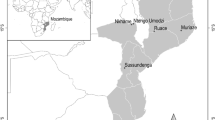Abstract
This research reports the effect of Bradyrhizobium spp strains on dry matter yield, nodulation and seed yield of soybean varieties grown in N-deficient soil in Uzbekistan in pot and field experiments, in 2001 and 2002. The results of experiments revealed that significant positive effects on growth, nodule number and yield of soybean were obtained after inoculation with Bradyrhizobium spp strains; and, generally, strains S62 and S63 were more effective than strain S61. The protein content of seeds also increased after inoculation. Both Orzu and Uzb2 soybean varieties gave a higher response than the Uzb6 variety.


Similar content being viewed by others
References
Alves BJR, Boddey RM, Urguiaga S (2003) The success of BNF in soybean in Brazil. Plant Soil 252:1–9
Bai Y, Pan B, Charles TC, Smith DL (2002) Co inoculation dose and root zone temperature for plant growth promoting rhizobacteria on soybean [Glycine max (L.) Merr] grown in soil-less media. Soil Biol Biochem 34:1953–1957
Bradford MM (1976) Estimation of protein in microgram quantities by protein/dye binding. Anal Biochem 72:248–254
Dashti N, Zhang F, Hynes R, Smith DL (1997) Application of plant growth promoting rhizobacteria to soybean (Glycine max [L.] Merr) increases protein and dry matter yield under short season conditions. Plant Soil 188:33–41
Daza A, Santamaría C, Rodríguez-Navarro DN, Camacho M, Orive R, Temprano F (2000) Perlite as a carrier for bacterial inoculants. Soil Biol Biochem 32:567–572
Döbereiner J (1992) Recent changes in concepts of plant bacteria interactions, endophytic N2-fixing bacteria. Cien Cult (Sao Paolo) 44:310–313
Groppa M, Zawoznik MS, Tomaro ML (1998) Effect of co-inoculation with Bradyrhizobium japonicum and Azospirillum brasilense on soybean plants. Eur J Soil Biol 34:75–80
Hansen AP (1994) Symbiotic N2 fixation of crop legumes. Margraf, Weikerschein
Höflich G (1993) Effect of variety and environmental factors on the phyto-effectivity of bacterial inoculations in peas. Zentralbl Mikrobiol 148:315–324
Höflich G, Wolf HJ, Rupprich A (1987). Bereitstellung und Sterilisation von Torf als Trägersubstrat für Rhizobium-Präparate. Zentralbl Mikrobiol 142:581–586
Hume DJ, Blair DH (1992) Effect of numbers of Bradyrhizobium japonicum applied in commercial inoculants on soybean seed yield in Ontario. Can J Microbiol 38:588–593
Jensen ES, Sørensen LH (1988) Uptake of soil nitrogen by soybean as influenced by symbiotic N2-fixation or fertilizer nitrogen supply. Soil Biol Biochem 20:921–925
Keeney DR, Nelson DW (1982) Nitrogen-inorganic forms. In: Page AL, Miller RH, Keeney DR (eds) Chemical and microbiological properties. (Methods of soil analysis, part 2) Agronomy 9:643–698
Molla AH, Shamsuddin ZH, Halimi MS, Morziah M, Puteh AB (2001) Potential for enhancement of root growth and nodulation of soybean co-inoculated with Azospirillum and Bradyrhizobium in laboratory systems. Soil Biol Biochem 33:457–463
Rahmani AH, Saleh-Rastin N (2001) A study of the effect of soil available N and indigenous rhizobial population on the growth and yield of soybean and modelling of the inoculation prediction. In: Horst WJ, et al (eds) Plant nutrition—food security and sustainability of agro-ecosystems. Wiley, New York, pp 680–681
Sessitsch A, Howelson JG, Perret X, Antoun H, Martinez-Romero E (2002) Advances in Rhizobium research. Crit Rev Plant Sci 21:323–378
Singh CS, Subba Rao NS (1979) Associative effect of Azospirillum brasilense with Rhizobium japonicum on nodulation and yield of soybean (Glycine max). Plant Soil 53:387–392
Smith RS (1992) Legume inoculant formulation and application. Can J Microbiol 38:485–492
Vincent JM (1970) A manual for the practical study of root nodule bacteria. (IBP handbook 15) Blackwell, Oxford
Wood M, Cooper JE, Holding AJ (1983) Method to assess the effects of soil acidity factors on legume–Rhizobium symbioses. Soil Biol Biochem 15:123–124
Zhang F, Dashti N, Hynes H, Smith DL (1996) Plant growth promoting rhizobacteria and soybean (Glycine max (L.) Merr) nodulation and nitrogen fixation at suboptimal root zone temperatures. Ann Bot 77:453–459
Author information
Authors and Affiliations
Corresponding author
Rights and permissions
About this article
Cite this article
Egamberdiyeva, D., Qarshieva, D. & Davranov, K. Growth and yield of soybean varieties inoculated with Bradyrhizobium spp in N-deficient calcareous soils. Biol Fertil Soils 40, 144–146 (2004). https://doi.org/10.1007/s00374-004-0755-1
Received:
Revised:
Accepted:
Published:
Issue Date:
DOI: https://doi.org/10.1007/s00374-004-0755-1




